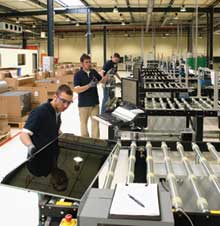Solar Industry: No Breakthroughs Needed
The federal government is behind the times when it comes to making decisions about advancing the solar industry, according to several solar-industry experts. This has led, they argue, to a misplaced emphasis on research into futuristic new technologies, rather than support for scaling up existing ones. That was the prevailing opinion at a symposium last week put together by the National Academies in Washington, DC, on the topic of scaling up the solar industry.

The meeting was attended by numerous experts from the photovoltaic industry and academia. And many complained that the emphasis on finding new technologies is misplaced. “This is such a fast-moving field,” said Ken Zweibel, director of the Solar Institute at George Washington University. “To some degree, we’re fighting the last war. We’re answering the questions from 5, 10, 15 years ago in a world where things have really changed.”
In the past year, the federal government has announced new investments in research into “transformational” solar technologies that represent radical departures from existing crystalline-silicon or thin-film technologies that are already on the market. The investments include new energy-research centers sponsored by the Department of Energy and a new agency called ARPA-Energy, modeled after the Defense Advanced Research Projects Agency. Such investments are prompted by the fact that conventional solar technologies have historically produced electricity that’s far more expensive than electricity from fossil fuels.
In fact, Energy Secretary Steven Chu has said that a breakthrough is needed for photovoltaic technology to make a significant contribution to reducing greenhouse gases. Researchers are exploring solar cells that use very cheap materials or even novel physics that could dramatically increase efficiency, which could bring down costs.
But industry experts at the Washington symposium argued that new technologies will take decades to come to market, judging from how long commercialization of other solar technologies has taken. Meanwhile, says Zweibel, conventional technologies “have made the kind of progress that we were hoping futuristic technologies could make.” For example, researchers have sought to bring the cost of solar power to under $1 per watt, and as of the first quarter of this year one company, First Solar, has done this.
These cost reductions have made solar power cheaper than the natural-gas-powered plants used to produce extra electricity to meet demand on hot summer days. With subsidies, which Zweibel argues are justified because of the “externalities” of other power sources, such as the cost from pollution, solar can be competitive with conventional electricity even outside peak demand times, at least in California. And projected cost decreases will make solar competitive with current electricity prices in more areas, even without subsidies.
Representatives of the solar industry say the federal government should do more to remove obstacles that are slowing the industry’s development. One issue is financing for new solar installations, which can be much more expensive if lending institutions deem them high risk. A recent extension of federal tax credits and grants for solar investments is a step in the right direction, many solar experts say. But more could be done. A price on carbon would help make solar more economically competitive and more attractive to lenders.
Keep Reading
Most Popular
Large language models can do jaw-dropping things. But nobody knows exactly why.
And that's a problem. Figuring it out is one of the biggest scientific puzzles of our time and a crucial step towards controlling more powerful future models.
The problem with plug-in hybrids? Their drivers.
Plug-in hybrids are often sold as a transition to EVs, but new data from Europe shows we’re still underestimating the emissions they produce.
Google DeepMind’s new generative model makes Super Mario–like games from scratch
Genie learns how to control games by watching hours and hours of video. It could help train next-gen robots too.
How scientists traced a mysterious covid case back to six toilets
When wastewater surveillance turns into a hunt for a single infected individual, the ethics get tricky.
Stay connected
Get the latest updates from
MIT Technology Review
Discover special offers, top stories, upcoming events, and more.